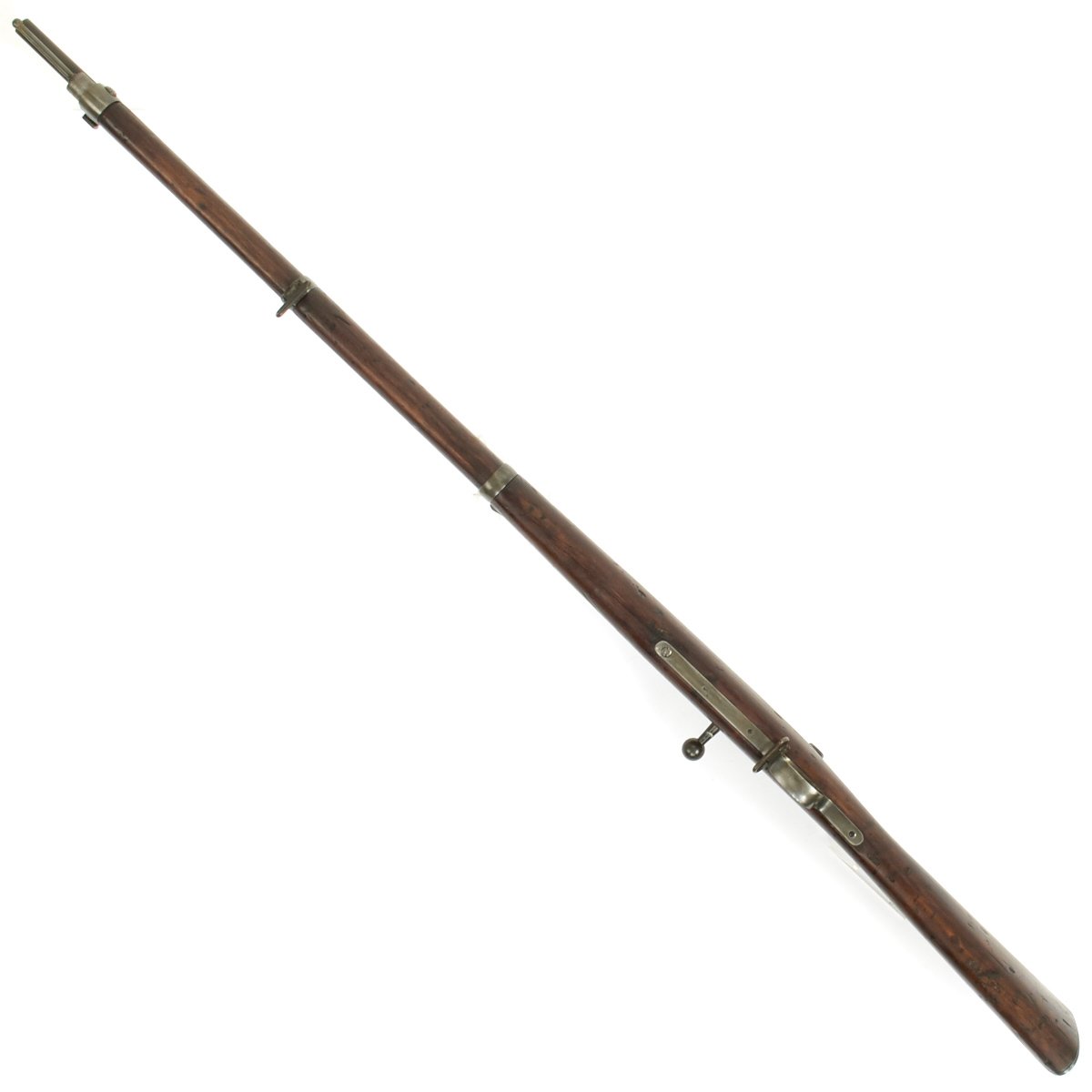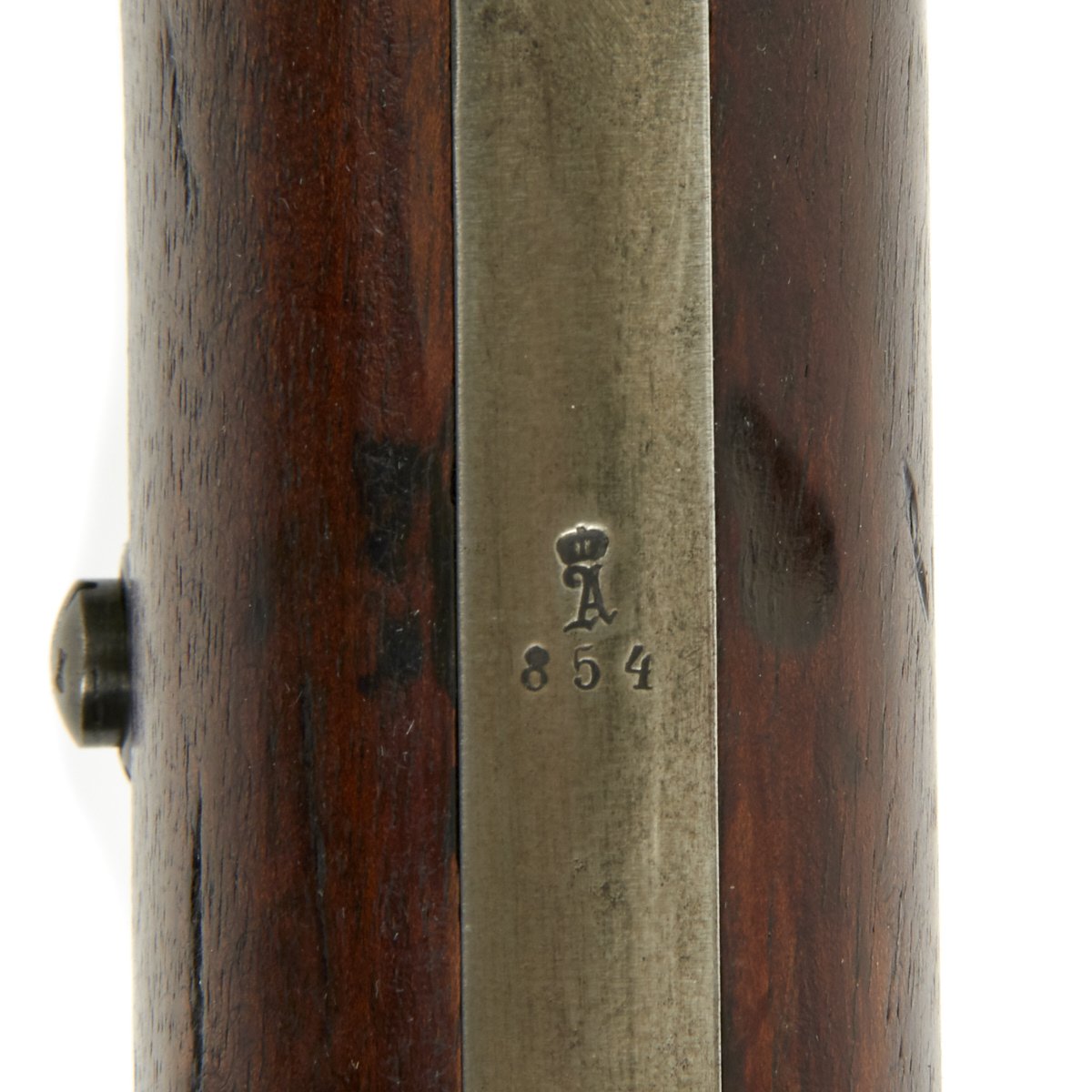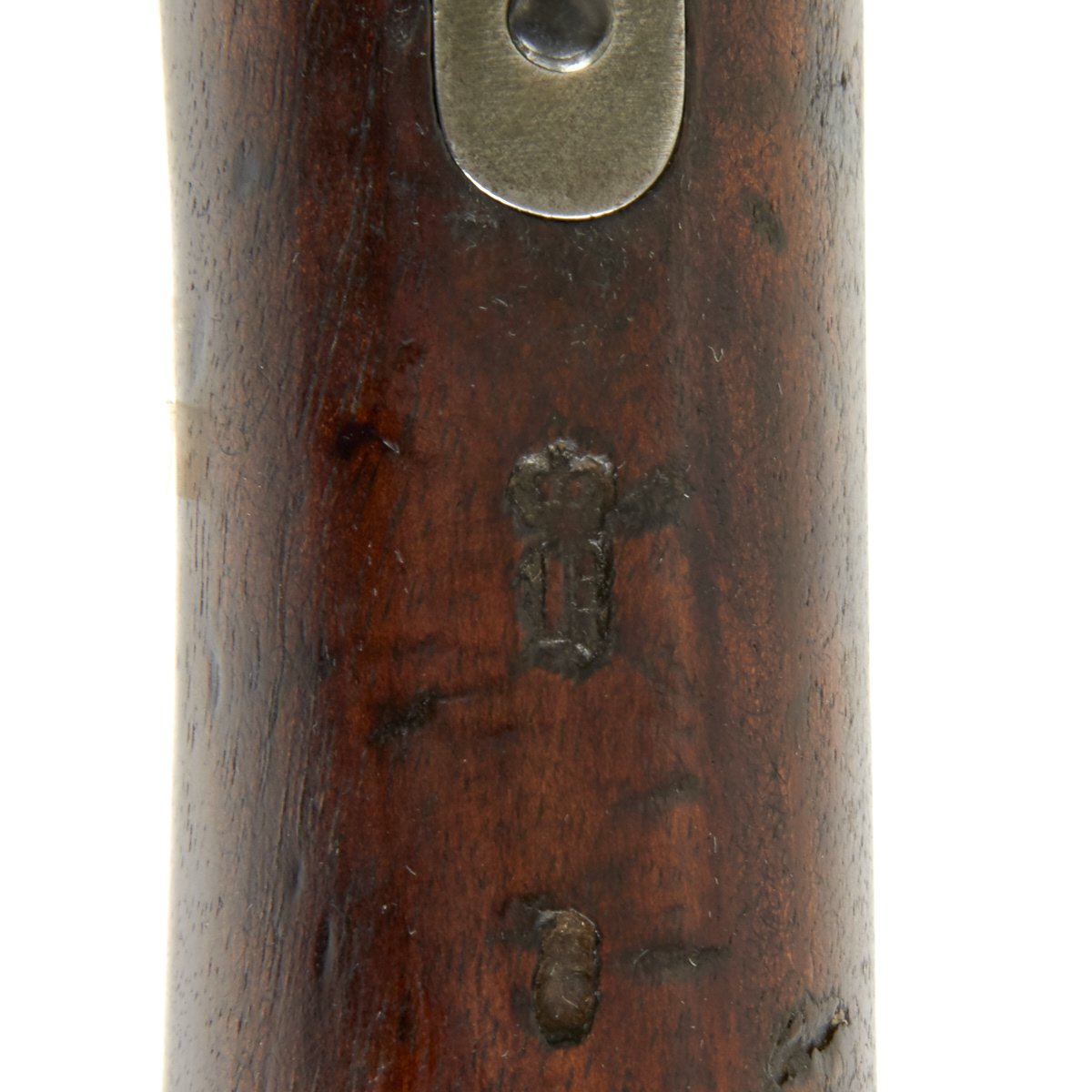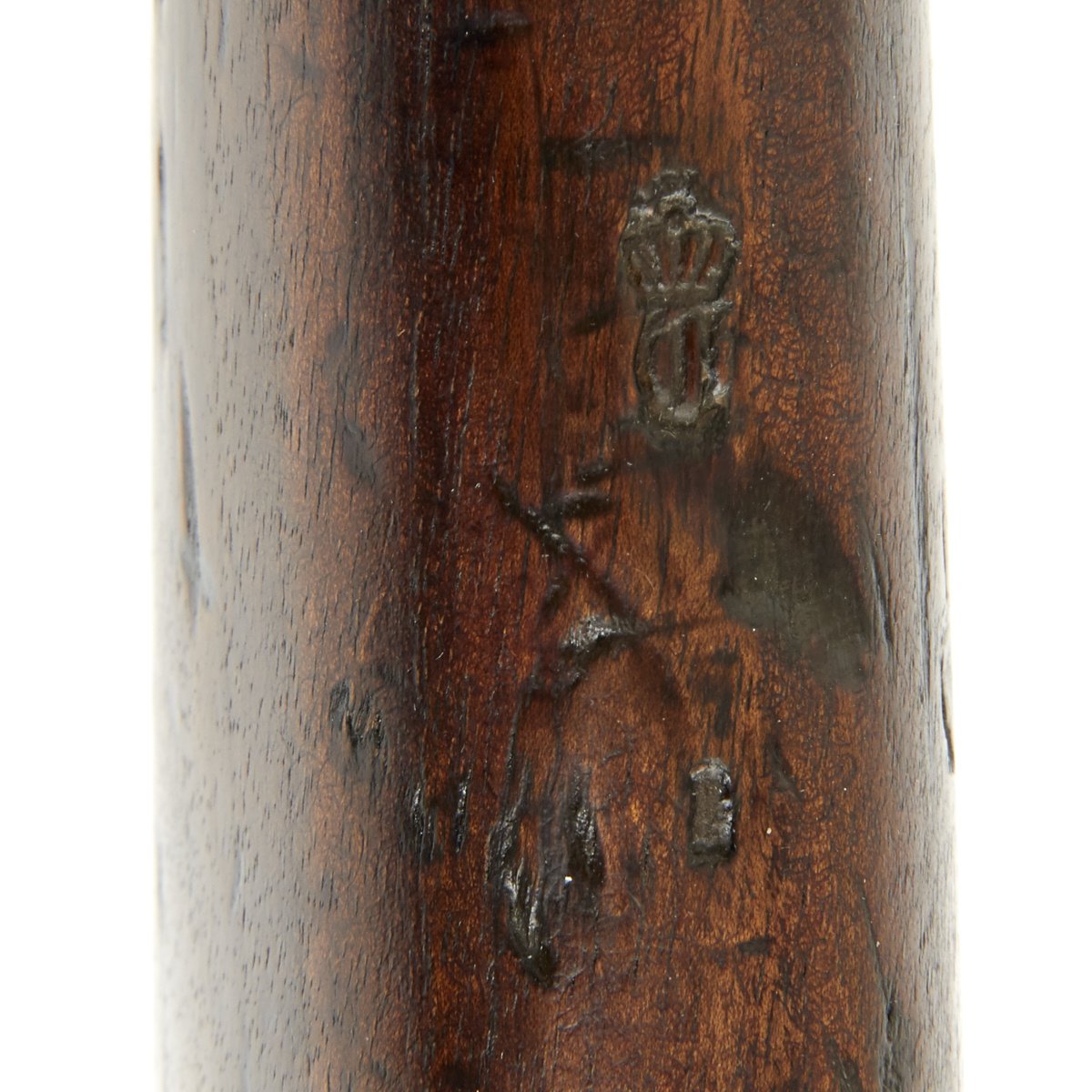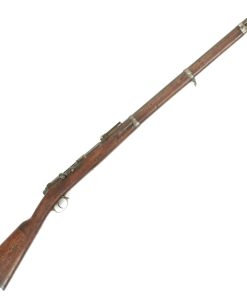Original German Mauser Model 1871/84 Rifle by Waffenfabrik Mauser with Matching Serial 8854A – Dated 1887 Original Items
$ 895,00 $ 223,75
Original Item: Only One Available. This is a wonderful example of the Mauser Model 1871/84 rifle. It is covered with Imperial German inspection and acceptance markings on the metal work, as well as on the wooden stock. The serial number 8854A appears on ALL metal components of the rifle. Major components like the barrel have the full serial number, while bolt components and barrel bands have 854, and screws are simply marked 54. This was to help keep track of all the parts when the rifle was at arsenal in service.
The receiver is dated 1887. and marked I. G. Mod. 71/84. on the opposite side. It also has regimental markings on the butt plate: 121.R.E.3.162.. This indicates issue to the 121st (3rd Württemberg) (Old Württemberg) Infantry Regiment, Ersatz (Replacement) Battalion, Company 3, Weapon 182. It is possible that this is not the first designation on the rifle, as the knoxform has date 10,95 (October 1895), indicating refurbishment at arsenal. It then may have been assigned to the Ersatz Battalion, which was a step above a Reserve unit, but still not regular front line.
One of the best features of this particular rifle is the maker, which is one that is rarely seen on this model. The top of the barrel knoxform is marked WAFFENFBK. MAUSER OBENDORF A/N, for the legendary Waffenfabrik (Weapons Factory) Mauser in Oberndorf am Neckar, a city in the Freiburg region of the Grand Duchy of Baden. This is the company that developed the Model 1871 and 1871/84, and is one of the most well-known names in German Arms production, even to this day. The factory was founded by the sons of master gunsmith Andreas Mauser: Wilhelm and Peter Paul (called Paul) Mauser. Wilhelm had assisted his father for years when he was ill, and had great knowledge and ability regarding finances and management. Younger brother Paul was a genius gunsmith, who showed an outstanding ability to develop methods of operation that were faster and more efficient. He also was somewhat unique in his ability to design and produce firearms as well as the ammunition for them, which followed during his entire career.
The Mauser 1871 was Paul Mauser’s first major design that was accepted, and it became the official long rifle of the German Empire. While they did design it. the majority of production was accomplished at the far larger government arsenals, such as Spandau, Erfurt, and Amberg. In 1884, two years after Wilhelm Mauser passed away at age 47, the partnership was turned into a Stock Company, now officially known under the name of Waffenfabrik Mauser. This coincided with the new tubular magazine design, which became the model 71/84. As before, only a small number were produced at the Obendorf Factory proper, so rifles bearing this maker mark are rare and highly desirable.
The rifle is complete with all major parts intact and functional. The bore is in very good condition, with crisp lands and grooves, and a mostly bright finish. The bolt moves freely, and the magazine cutoff is functional, as is the “wing” safety. The exterior metal finish on the fittings does show some wear, but still has a lot of the original bluing, and is most attractive. The wood stock is in very good condition, and still has many proofs that are clear and crisp. The beech wood has a lovely aged brown color, with some flame/figuring on the buttstock. The stock does have the expected dents and dings from long service, but is overall quite nice.
This gun is most likely a WW1 Veteran’s “bring back” souvenir, as this rifle is in very good condition. Great quantities of these 71/84 Rifles were pressed into service in WW1 since great piles of them had been put into storage in 1888 with the introduction of the M-1888 7.92mm German Commission Rifle.
Originally adopted as the Gewehr 71 or Infanterie-Gewehr 71, or “Infantry Rifle 71 (“I.G.Mod.71” was stamped on the rifles themselves) this was the first rifle model in a distinguished line designed and manufactured by Paul Mauser and Wilhelm Mauser of the Mauser company, and later mass-produced at Spandau arsenal.
Paul Mauser developed his bolt-action rifle from 1866 to 1871. During 1870-71 trials with many different rifles took place, with the “M1869 Bavarian Werder” being the Mausers’ chief competitor. The Mauser was provisionally adopted on 2 December 1871, pending the development of an appropriate safety. With support from the government’s Spandau arsenal, the improvements to the safety mechanism were completed and the rifle was formally accepted on 14 February 1872 as Infantry Rifle Model 1871 by the German Empire excluding Bavaria. The action was not based on its predecessor, the Dreyse needle gun which had seen service during the Franco-Prussian War of 1870-71, and which was found to have a number of weaknesses.
The now well known Mauser “wing” type safety lever was developed for the Gewehr 71. The Gewehr 71 is a conventional looking bolt action chambered in 11mm using black powder cartridges. The action included only a bolt guide rib as its single locking lug, locking forward of the receiving bridge. The original design was a single-shot. The design was updated in 1884 with an 8-round tubular magazine designed by Alfred von Kropatschek, making this Germany’s first repeating rifle. This version was designated the Gewehr 1871/84. A version of this repeater was adopted by the Ottoman Empire. Designated the M1887, it differentiated from the M71/84 in that it had a side mounted cleaning rod, a second locking lug on the rear of the bolt, and it was in caliber 9.5×60mmR, which Paul Mauser touted as the most efficient (black powder) cartridge. In the early 20th century a few were converted to 7.65×53mm smokeless by the arsenal in Ankara.
Offered in very nice fully functional condition.
Specifications-
Year of Manufacture: 1887
Caliber: 11x60mmR Mauser
Cartridge Type: Centerfire Cartridge
Barrel Length: 32 inches
Overall Length: 51 Inches
Action type: Bolt-Action
Feed System: 8 Round Tubular Magazine
NOTE: International orders of antique firearms MUST be shipped using UPS WW Services (courier). USPS Priority Mail international will not accept these.
Fast Shipping with Professional Packaging
Thanks to our longstanding association with UPS FedEx DHL, and other major international carriers, we are able to provide a range of shipping options. Our warehouse staff is expertly trained and will wrap your products according to our exact and precise specifications. Prior to shipping, your goods will be thoroughly examined and securely secured. We ship to thousands clients each day across multiple countries. This shows how we're dedicated to be the largest retailer on the internet. Warehouses and distribution centres can be located throughout Europe as well as the USA.
Note: Orders with more than one item will be assigned a processing date depending on the item.
Before shipping before shipping, we'll conduct a thorough inspection of the items you have ordered. Today, the majority of orders will be delivered within 48 hours. The delivery time will be between 3-7 days.
Returns
The stock is dynamic and we cannot completely manage it because multiple stakeholders are involved, including our factory and warehouse. So the actual stock may alter at any time. It's possible that you may not receive your order once the order has been made.
Our policy is valid for a period of 30 days. If you don't receive the product within 30 days, we are not able to issue a refund or an exchange.
You can only return an item if it is unused and in the same state as the day you received it. You must have the item in its original packaging.
Related products
Uncategorized
Uncategorized
Armoured Fighting Vehicles of the World: AFVs of World War One (Hardcover Book) New Made Items
Uncategorized
Angolan Rebel 1970s era 60mm Inert Display Mortar from Angolan Civil War Original Items
Uncategorized
Uncategorized
Uncategorized
Uncategorized
Uncategorized
Uncategorized
Uncategorized
Uncategorized
Uncategorized
Uncategorized


